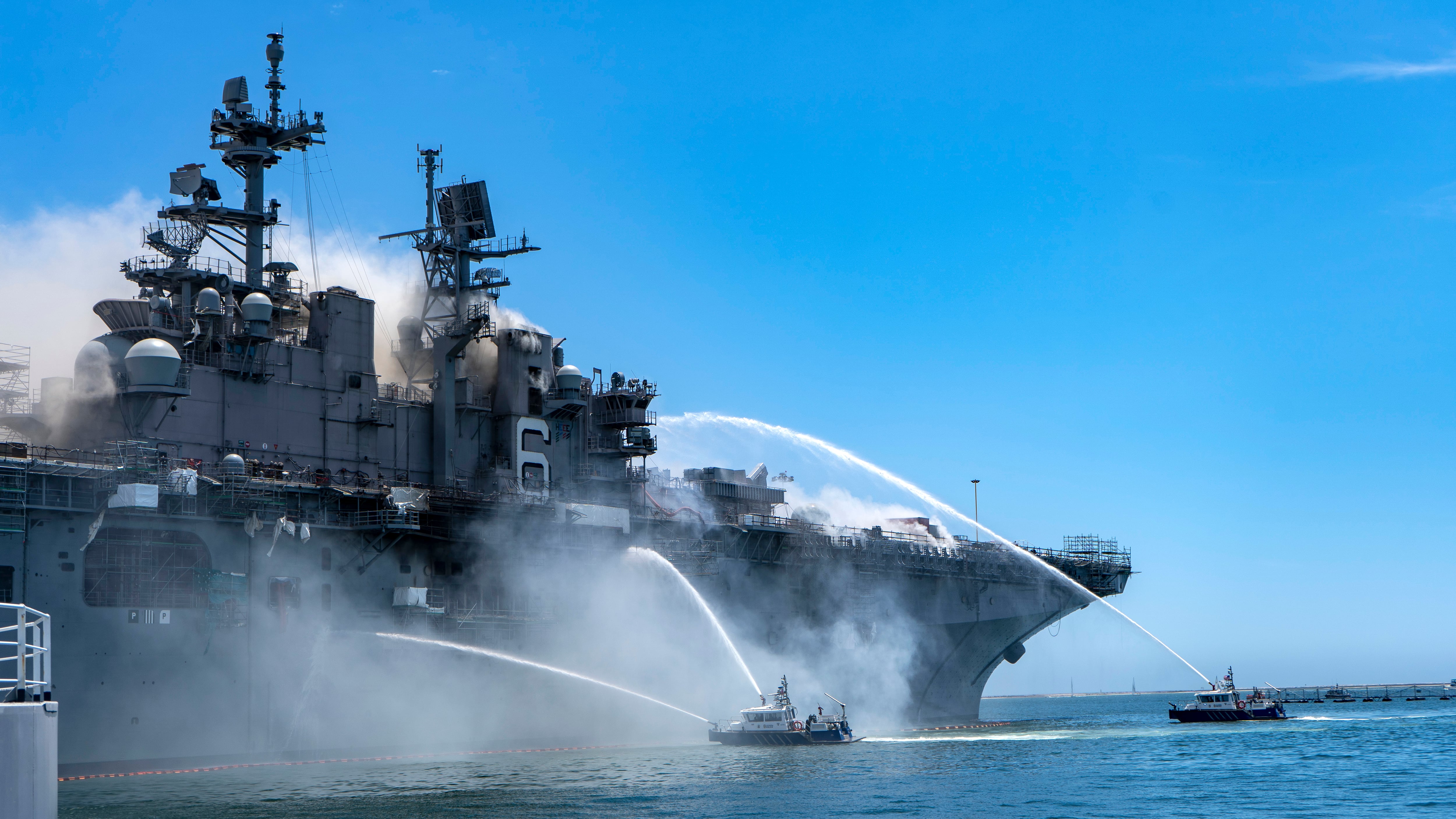WASHINGTON — A series of explosions and a 1,200-degree inferno damaged 11 of the amphibious assault ship Bonhomme Richard’s 14 decks, according to a summary of the damage by the U.S. Navy’s top officer, which was obtained by Defense News.
Chief of Naval Operations Adm. Michael Gilday, in a letter to the service’s admirals and master chiefs, said the fire caused “extensive damage” to the ship.
“There is fire and water damage, to varying degrees, on 11 of 14 decks,” Gilday wrote. “With the flight deck as a reference, I walked sections of the ship 5 levels below and had the opportunity to examine the superstructure.
“The island is nearly gutted, as are sections of some of the decks below; some perhaps, nearly encompassing the 844 ft length and 106 ft beam of the ship ([Naval Sea System Command’s] detailed assessment is ongoing). Sections of the flight deck are warped/bulging.”
RELATED

The letter does not address one of the key questions in the wake of the fire: What will become of the ship? The Navy has a long history of reviving its damaged ships as it did with the destroyers Fitzgerald and McCain, and Congress is usually willing to float the money. But it’s unclear if the Navy will want to invest what will likely be hundreds of millions of dollars into a 22-year-old ship. After a 2012 fire onboard the attack submarine Miami, the Navy determined the roughly $700 million price tag was too steep to justify.
The fire on the Bonhomme Richard broke out the morning of July 12 while it was pierside in San Diego, California, undergoing maintenance. The blaze was aided by wind and explosions, Gilday wrote.
“While response from the crew and federal firefighters was rapid, preliminary reports indicate there were two main factors that contributed to the intensity, scope, and speed of the fire,” Gilday wrote. “First was wind that fueled the fire as the vehicle storage area leads to the well deck, which opens to the air at the stern gate. The second were the explosions, one in particular, reportedly heard about 13 miles away.
“The explosions, some were intense, and the uncertainty of their location and timing, led to a situation, that might have been under control late Sunday night, but expanded into a mass conflagration, spreading quickly up elevator shafts, engine exhaust stacks, and through berthing and other compartments where combustible material was present.”

In the letter, Gilday praised the work of Bonhomme Richard’s crew, as well as the hundreds of sailors who rushed to the scene, many without orders to do so. Several dozen sailors and civilian firefighters were hospitalized, most with smoke inhalation and heat injuries.
“There were Sailors from across the San Diego waterfront who responded to this fire — hundreds of them; many without receiving direction to do so,” Gilday wrote. “Every single fire team was led by BONHOMME RICHARD Sailors — no question, this was THEIR ship and they would walk point on every firefighting mission. Most had to be ordered … and re-ordered … to go home at some point and get some rest.
“I also met with the air crews of HSC-3; the aerial bucket brigade who dropped nearly 700K gallons of water on the blaze, day and night, from their helos. Their efforts were critical in helping get the fire under control; and they used their IR [infrared] capability to locate hot spots and vector fire teams to the source. Awe inspiring teamwork.”

Gilday closed the letter by pledging to learn from the fire and to draw on the positives from the situation.
“We will thoroughly look into and learn from the fire on BONHOMME RICHARD,” he wrote. “We will be committed to doing that together. I have no doubt about that.
“As we look hard into recent events — and revisit and assess what we’ve learned from previous incidents, I am relying on you to reinforce those aspects of our culture demonstrated on BONHOMME RICHARD and across the Navy right now. Focus on the positive attributes — that will overcome the negatives we want to avoid.”
David B. Larter was the naval warfare reporter for Defense News.






